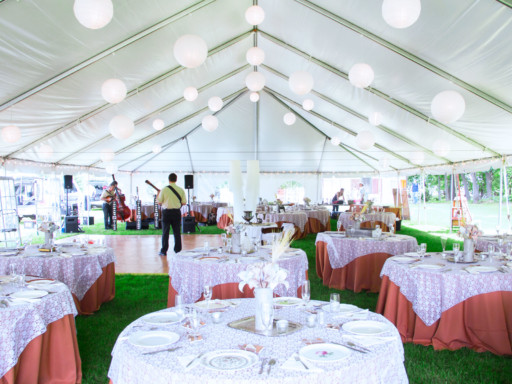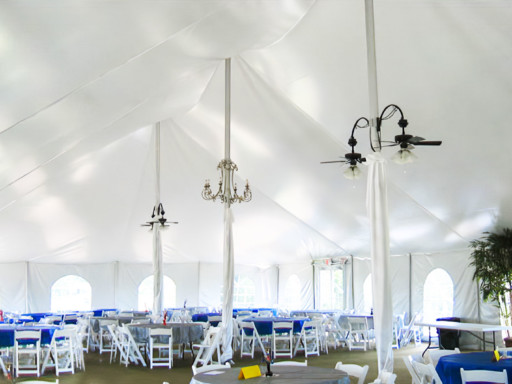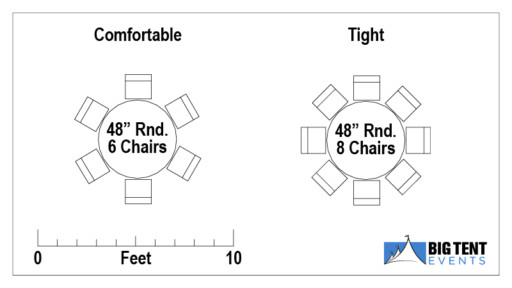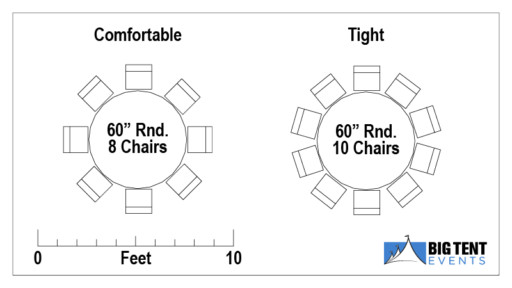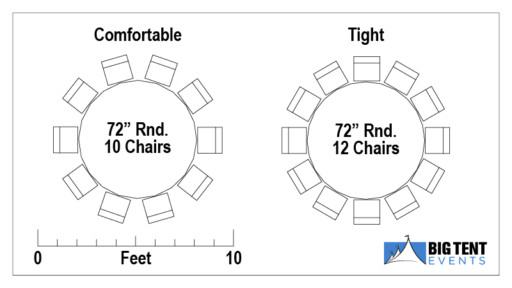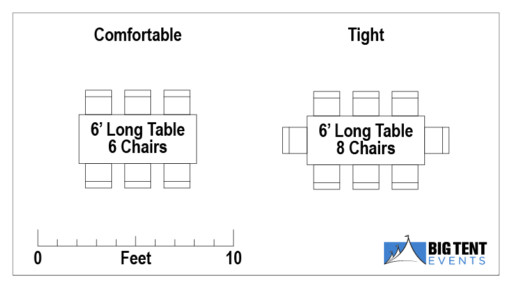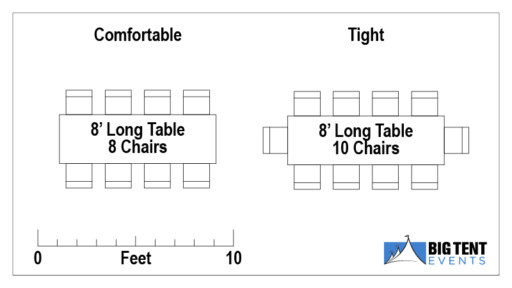Wedding Tent Styles
Outdoor Wedding Tent rentals allow brides a unique wedding venue that has flexibility not normally found in a traditional banquet hall setting. The style of tent may be dictated by the outdoor venue that you have selected for your wedding. The number of guests, type of meal (buffet or served), dance floor, D.J. or band, and head table size will all need to be taken into consideration as well.
The surface that the tent will be installed on also needs to be taken into consideration when choosing a tent style for your wedding. Traditional pole tents and frame tents can be installed over grass, but if the tent is being installed over cement or asphalt, a frame tent will need to be used.
Frame Tents
Frame tents have a skeleton like frame and perimeter legs that support the weight of the top and therefore have no center poles. Frame tents offer an unobstructed space under the tent and are able to be installed on most surfaces. Frame tents can be secured with water barrels or weights but staking is always preferred.
Pole Tents
Pole tents have center poles that support the main weight of the tent. Side poles with straps are placed around the perimeter and secured with stakes to create tension and to pull the tent into its popular shape of high peaks and elegant swoops between the tent peaks. Pole tents must be secured with stakes.
Things to Consider
As you begin planning for a wedding there are several items that need to be taken into consideration. The where, when and how many are just the beginning of your wedding planning. Let Big Tent Events help you with your wedding planning for a beautiful outdoor wedding. We have broken down each step that will be important to think about as you move through the planning process for an outdoor wedding.
When is your wedding?
Mid-May through September are the most popular months for outdoor wedding receptions. Your wedding date will determine if you need to consider adding sidewall, heating or cooling option to your rental budget. During rainy months sidewall is an option you may want to consider. Mid June through September we strongly suggest that you consider using a mosquito abatement service for the comfort of you and your guests.
How many guests?
Start high and reduce if necessary. Depending on the venue you have selected, you may need to decrease the number of guests you are able to invite to your wedding. No matter what venue you select for your wedding, available space is not always something you can control. Keep in mind that it’s not only the guests that take up room in a banquet hall or under a tent, buffet tables, bars, and the dance floor all require a set amount of space. 60″ round tables are most often used for guest seating as they are the easiest to place under tents.
What time is the reception?
Are you having an afternoon wedding and reception or an afternoon wedding with an evening reception? Like the time of year, the time of day will determine if lighting is needed.
- In May the sun sets approximately 8:00pm
- In June the sun sets approximately 8:30pm
- In July on the 1st. the sun sets approximately 8:30pm and by the 31st. the sun sets at about 8:00pm
- In August on the 1st. the sun sets around 8:00pm and by the 30th sun sets around 7:30pm
- In September the sunsets start at 7:30pm on the 1st and by the 30th sunset is around 6:30pm
Basically if you are having an evening wedding reception, plan on renting lighting for your tent. Tent lighting is available in many different styles from the simple pure look of our white globe lights to chandeliers and supplemental par lighting. The style of rental tent, time of day, time of year and your own personal style will help determine the best tent lighting option.
Tent lighting will need at least one 20 amp circuit within 50′ of the tent and should not be on the same circuit as coffee makers, your caterers food service equipment or the band or D.J..
Where is the wedding reception being held?
Backyards, churches, public parks and private venues are the most popular locations for outdoor wedding receptions. The location of the wedding reception may limit the size or style of tent that can be used. Backyards, churches and private venues such as country clubs often have limited areas where tents are able to be installed, but are usually more flexible for delivery and removal of equipment. Public venues such as forest preserves and park district properties typically have unlimited space available, but have restrictions on when the area can be used leading to specific delivery and removal times.
When choosing your venue be sure that you look at the restroom facilities, are there enough available to accommodate your guests? You may need to rent portable toilets or a trailer unit.
Power is one key element that is often overlooked. Be sure to find out how much power is available, where it is available, how far is power source from the tent, and how many 20 amp circuits are required by your tent rental company, your caterer and your D.J. or Band. Generator rental may be required.
When tents are secured with stakes all tent companies are required by law to contact the JULIE one call service to have any public utility lines marked. JULIE requires at least 48 hours prior to installation to have lines marked. JULIE does not mark any non-public lines such as sprinkler system, landscape lighting, swimming pool, septic system, etc., it is the responsibility of the property owner to mark these lines.
What type of meal is planned?
Are you having a buffet or a served meal? Buffet meals require more room than served meals. Buffet stations will require more space than a traditional long buffet as they are generally placed throughout the tent. Once the meal is over, buffet tables are generally reused for a sweets station, desserts, coffee stations, etc.. If buffet tables are being used after the meal is completed, be sure that you have extra clean linens for tables that may need them.
Served meals and family style meals do not require additional space for food service, but do require more wait staff.
Your caterer will be able to tell you the number and size tables they will need for food service. Your caterer may also request a prep tent or a designated prep area and extra long tables for their use. If coffee is being brewed on site be sure that the power outlet being used is not on the same circuit as the D.J., Band, or tent lighting. Coffee pots draw a lot of power.
Will there be bars or just beverage stations?
Bars and beverage stations will need their own tables and floor space. Beverage stations and self serve bars are generally single sided and do not have staff attending them at all times. Traditional bars with a bar tender require more room than a beverage station. Your bar tender will need a work space as well as an area for additional supplies. A bar table with a riser shelf for service and a back bar will make your bar tender happy. Don’t forget to add a meal in for your bar tender.
Tip: 1 buffet table for every 50 guests, 1 bar set up for every 100 guests, only about 1/3 of the guests will drink coffee
Are you having a D.J. or a band?
If you are having a D.J. at your wedding reception, be sure to add an 8′ long table for his or her equipment. Some D.J.’s will ask for a riser so that their equipment is not sitting on the ground. A D.J. needs power so be sure to ask how many 20 amp circuits are required. The outlet or outlets being used by the D.J. should be on a separate circuit from the caterer and tent.
If you are having a band find out what size stage or riser they require. The band riser is generally set behind the dance floor, but can also be set next to the dance floor. Like a D.J. you will need to find out how many 20 amp circuits are required for their equipment.
Remember your D.J. or band are playing throughout the entire reception be sure to add in meals to cover them.
Head table or no head table?
Head tables are based on the total number in the bridal party. Many brides are choosing not to have a traditional head table. Sweetheart tables for just the Bride and Groom are becoming popular because the members of the bridal party are able to sit with their guests. Round, oval and square tables are popular head table options.
Traditional long head tables are easily installed on risers that are eight feet deep and as long as the head table itself.
Post Wedding Receptions and Celebration Parties typically do not have a head table or designated seating.
Decorating your wedding tent
Tent accessories are the extras that will make your wedding reception unique and show off your personality or theme.
Seating Guidelines
What goes under the tent?
When you begin planning your guest seating arrangement, remember that there are other items that need to be under the tent as well. Buffet tables, the dance floor, the D.J. or band, bars or beverage stations, sweets tables, and your head table all need to have room under the tent. Place the big stuff first i.e. the dance floor, band, band riser, head table, and buffet tables, and only then work on placing your seating tables around them.
How many people to a table?
We always ask our customers “How man guests would you like to seat per table?” What was your answer? If you said 10, you are like most people. 10 is an easy number to work with on paper, but 10 doesn’t always work well with tables, guest comfort, and the space available.
72" Round Tables
72” round tables allow you to seat 10-12 guests, but they have several disadvantages. It is difficult to have a conversation with someone sitting 6 feet away, and centerpieces need to be larger to fill the 4-foot area in the middle of the table. 72” round tables also create unusable areas in tents less that 60” wide.
